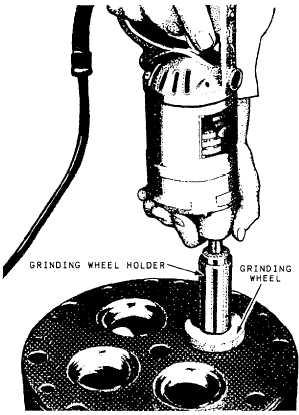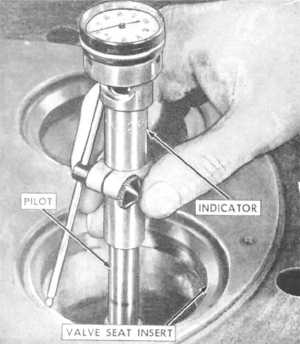In any valve reconditioning job, the valve seat must be
concentric with the valve guide. You can determine the
concentricity with a dial indicator, as shown in figure
3-12.
If you must grind a valve seat, hold hand grinding
to a minimum and never use it in place of machine
grinding, in which a grinding stone is used to refinish
the seat (fig. 3-13). Grind the seat a few seconds at a
time until it is free of pits. Check the seat after each cut.
The primary objection to hand grinding the valve to
the seat is that a groove or indentation may be formed
in the valve face. Since the grinding is done when the
valve is cold, the position of the groove with respect to
the seat is displaced as the valve expands slightly when
the engine is running. This condition is illustrated
(greatly exaggerated) in figure 3-14. Note that when the
valve is hot, its ground surface does not make contact at
all with the ground surface of the seat. Therefore, hand
grinding should be used only to remove slight pitting or
as the final and finishing operation in a valve
reconditioning job.
Some valves and seat are not pitted sufficiently to
require replacement but are pitted to such an extent that
hand grinding would be unsatisfactory. Such valves may
be refaced on a lathe (fig. 3-15), and the valve seats may
be reseated by power grinding equipment (fig. 3-13).
Figure 3-12.—Determining concentricity of the valve seat with a
dial indicator.
Figure 3-13.—Machine grinding a valve seat.
Normally, these operations are done at a repair base or
naval shipyard.
A valve head that is excessively reground to such an
extent that its edge is sharp, or almost sharp, will soon
burn. A sharp edge cannot conduct the heat away fast
enough to prevent burning. This is the factor that limits
the extent to which a valve may be refaced.
BROKEN VALVE SPRINGS
Broken valve springs cause excessive valve noise
and may cause erratic exhaust gas temperatures. The
actual breaking of the valve springs is not always the
most serious consequence. Actions following the
breaking cause the most serious damage to the engine.
When a spring breaks, it may collapse just enough to
allow the valve to drop into the cylinder, where it may
be struck by the piston. In addition, the valve stem locks
or keepers may release the valve and allow it to drop
into the cylinder, causing severe damage to the piston,
cylinder head, and other nearby parts.
You can take a number of precautions to prevent or
minimize corrosion and metal fatigue, which cause
valve springs to break Be reasonably careful when you
3-10




